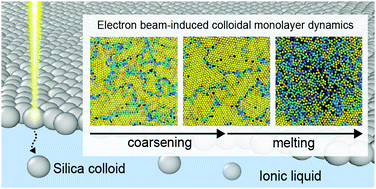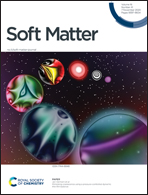Charging-driven coarsening and melting of a colloidal nanoparticle monolayer at an ionic liquid–vacuum interface†
Abstract
We induce and investigate the coarsening and melting dynamics of an initially static nanoparticle colloidal monolayer at an ionic liquid–vacuum interface, driven by a focused, scanning electron beam. Coarsening occurs through grain interface migration and larger-scale motions such as grain rotations, often facilitated by sliding dislocations. The progressive decrease in area fraction that drives melting of the monolayer is explained using an electrowetting model whereby particles at the interface are solvated once their accumulating charge recruits sufficient counterions to subsume the particle. Subject to stochastic particle removal from the monolayer, melting is recapitulated in simulations with a Lennard-Jones potential. This new driving mechanism for colloidal systems, whose dynamical timescales we show can be controlled with the accelerating voltage, opens the possibility to manipulate particle interactions dynamically without need to vary particle intrinsic properties or surface treatments. Furthermore, the decrease in particle size availed by electron imaging presents opportunities to observe force and time scales in a lesser-explored regime intermediate between typical colloidal and molecular systems.



 Please wait while we load your content...
Please wait while we load your content...